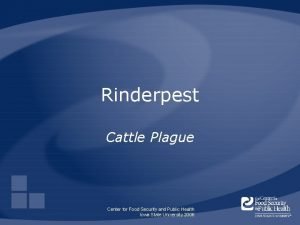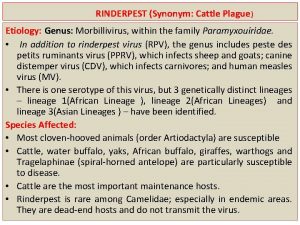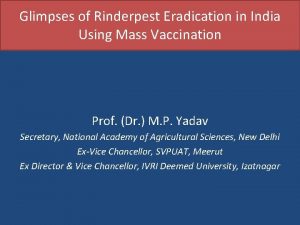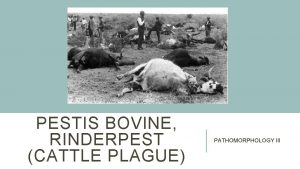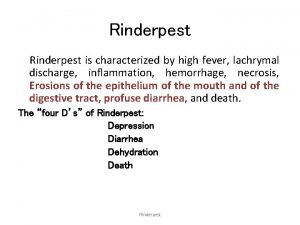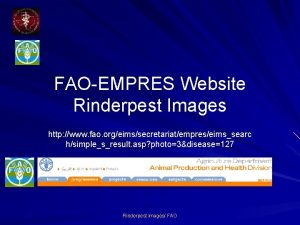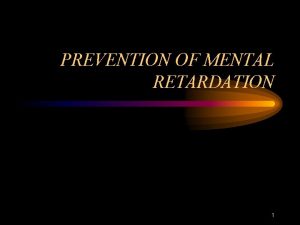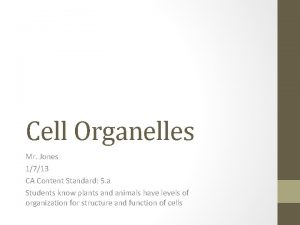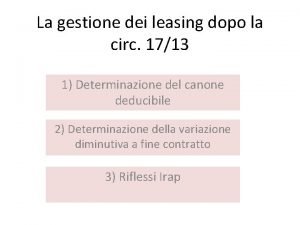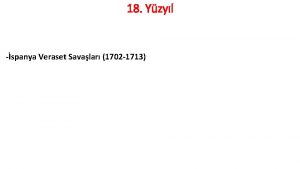The History of Prevention of Epidemics Rinderpest 1713












































- Slides: 44

The History of Prevention of Epidemics: Rinderpest 1713 AD to Smallpox 1796 AD to Measles AD 1963 -What to do or not to do and if given, how to do it safely. James M. Oleske, MD, MPH François-Xavier Bagnoud Professor of Pediatrics Director, Division of Pediatrics Allergy, Immunology & Infectious Diseases Peter Wenger MD FAAP, FIDSA Department of Pediatrics, New Jersey Medical School, Newark, New Jersey

Eradication of Rinderpest-95% Infection fatality Rate in clovenfooted beasts n 1713 • Pope Clement XI asked Dr. Giovanni Lancisi to stop outbreak in papal herds n Charlatan cures banned n Priests ordered to preach from their pulpits • All herds with sick members slaughtered and buried in lime • Isolate healthy herds n Laymen found resistant or cheating • Hanged and drawn and quartered n Disobeying priests were imprisoned for life • Within 9 months the outbreak ended in Papal states n It persisted for 100 years with >200 million dead

Eradication of Rinderpest : A Costly Success By the 1750’s crude “vaccine” used in England Netherlands: 50 years before Jenner ! n 1761 first school of veterinary medicine founded in Lyon, France n 1924 creation of the World Organization for Animal Health in response to a devastating European outbreak n 1950’s Rinderpest was eradicated n

Elephant RIDE – UNINTENDED CONSEQUENCES

Measles (Rubeola) Virology n n Genus: Morbillivirus Family: Paramyxoviridae Canine distemper and rinderpest viruses Spherical, enveloped, single-stranded RNA virus • Six identified structural proteins: 3 complexed with RNA to form nucleocapsid P, L, N protein and 3 complexed with viral envelope (F, H, and M http: //biowiki. org/twiki/pub/Fall 09/Measles. Virus/Measles_virus. JPG

Measles Virology n Genetic variety • WHO recognizes 23 genotypes n phylogenetic analysis of the N gene • Biologic significance unknown • Allows monitoring transmission pathways • Immune response generated through immunization protects against all strains n Molecular sequencing can distinguish between wild-type and vaccine-virus

Measles Epidemiology 1 n n Humans are the only natural hosts • No animal reservoirs Highly contagious • Attack rate in susceptible household contacts: 75%-90% • Direct contact with infectious respiratory secretions n Large respiratory droplets and droplet nuclei • Lingers for at least 2 hours • Requires airborne precautions n Nasopharynx and conjunctiva

Measles Epidemiology 2 n n n Incubation period: 8 -12 days Contagious period: 1 -2 days before symptom onset (3 -5 days before rash) to 4 days after rash appearance • Immunocompromised patients may demonstrate prolonged excretion of virus Peak incidence in temperate regions is late winter and spring • Low relative humidity Pre-vaccine era • Pre-school and young school age children • Few susceptible by 20 years of age Immunity appears to be lifelong • Wild-type infection or vaccine-induced • Primary vaccine failure (≥ 12 months) ~5% n Most infections in previously immunized children

Measles Pathophysiology Infects epithelial, reticuloendothelial, and white blood cells • Multiple organ systems n Multinucleated giant cells found throughout the respiratory and GI tracts and in most lymphoid tissue on autopsy n Onset of rash coincides with appearance of serum antibodies • Skin and mucous membrane manifestations may represent a hypersensitivity reaction to the virus*Perry RT, Halsey NA. The clinical significance of measles: a review. JID. 189 • Decline in CD 4 cells (Suppl 1) S 4 -S 16. May 1, 2004 n

Measles Clinical Presentation 1 Prodromal (2 -4 days) • Fever (39°C– 40. 5°C), cough, coryza, and conjunctivitis n Symptoms intensify and usually peak on first day of rash • Appearance of Koplik spots appear 1 day prior to rash onset and last 2 -3 days n Buccal mucosa opposite 1 st molar n Soft palate, conjunctiva, vaginal Perry RT, Halsey NA. The clinical significance of measles: a review. JID. 189 mucosa (Suppl 1) S 4 -S 16. May 1, 2004 n

Koplik Spots http: //www. pathguy. com/sol/24924. jpg

Koplik Spots http: //eso-cdn. bestpractice. bmj. com/best-practice/images/ bp/en-gb/217 -4 -tn_default. jpg

Measles Clinical Presentation 2 Rash first appears on face and neck n • Discrete erythematous patches (3 -8 mm) n Lesions increase and spread downwards to trunk and extremities (including palms in 25%-50%) • Most intense over face and trunk n Frequently become confluent n Rash persists for 3 -7 days • Desquamation may appear but not pronounced • Severe desquamation seen in malnourished children n Immunocompromised patients may demonstrate an atypical presentation Perry RT, Halsey NA. The clinical significance of measles: a review. JID. 189 (Suppl 1) S 4 -

http: //aapredbook. aappublications. org/week/iotw 010504. dtl

http: //www. cdc. gov/measles/about/photos. html

http: //www. cdc. gov/measles/about/photos. html

Measles Clinical Presentation 3 n Common associated signs and symptoms • Photophobia secondary to iridocyclitis • Sore throat • Headache • Abdominal pain

n Measles Complication Risk Factors At greatest risk • <5 years and ≥ 20 years • Immunocompromised n T-cell suppression: Congenital or acquired T-cell deficiencies: 60% of all measles-associated deaths in NJ in 1990 -1991 occurred in HIV-infected children* • Chemotherapy for cancer or steroid therapy • Bone marrow transplantation • Malnourished n Protein losing enteropathy, increased metabolic demand, decreased food intake n Vitamin A deficiencies: Measles infection lowers serum retinol levels • Crowded living conditions n Developing countries *Palumbo P, Hoyt L, et al. Population-based study of measles and measles immunization in HIV-infected children. PIDJ. 11: 1008 -14. 1992

Measles: Respiratory Complications n § § § n PNEUMONIA: Most common severe complication, responsible for most measles-associated deaths due to: Viral: Measles or Secondary infection with adenovirus or HSV, Bacterial: Streptococcus pneumoniae, Staphylococcus aureus, H. influenzae Immunocompromised Host: Diffuse Progressive Measles Pneumonitis (DPMP) most common cause of death=Hecht’s giant cell pneumonia OTITIS MEDIA: Most common complication in US 14% of children under 5 years of age LARYNGOTRACHEOBRONCHITIS: “measles croup” Perry RT, Halsey NA. The clinical significance of measles: a review. JID. 189 (Suppl 1) S 4 n S 16. May 1, 2004 nd

n Measles: Neurological Complications Febrile Seizures: 0. 3%-2. 3% in hospitalized children in US and UK (benign, with no long term residual damage) n Encephalitis: a. Post Infectious Encephalomyelitis (PIE); 1 -3/1000 infections; onset 3 -10 days post rash onset ; Highest incidence in adolescents and adults; ~25% case fatality rate &~33% have neurological sequelae; b. Subacute Sclerosing Pan-Encephalitis (SSPE), persistence of measles virus in CNS, slowly progressive infection and demyelization to Vegetative state, 1/8. 5 million US cases, onset 7 -10 years post acute infection ( Disappeared in Perry RT, Halsey NA. The clinical significance of measles: a review. JID. 189 (Suppl 1) S 4 -S 16. 5/1/04

n n Measles Complications-GI and Ocular Diarrhea • Most common in people <5 years and >30 years • 30%-70% of hospitalized patients with measles in US • Typical onset just before rash • Dehydration common Blindness • Keratitis (inflammation of the cornea) n Common n Secondary infections with viruses (adenovirus, HSV) and bacteria (Pseudomonas spp. and staph) n Scarring and blindness • Vitamin A deficiency • Cortical damage secondary to encephalitis Perry RT, Halsey NA. The clinical significance of measles: a review. JID. 189 (Suppl 1) S 4 -S 16. May 1, 2004

Global Situation* n n In 2008, ~83% of the world’s children received one dose of measles-containing vaccine (MCV) by their first birthday • Up from 72% in 2000 In 2008 there were an estimated 164, 000 deaths due to measles • A 78% decrease (733, 000 deaths) since 2000 • >95% of deaths in low-income countries with weak health infrastructures • Mainly seen in children <5 years of age *WHO estimates. See http: //www. who. int

United States. Stable Misery • Pre-vaccine era ( befor 1963 Licensure) n ~500, 000 cases annually • In reality, ~4 million infected/year n ~500 deaths n ~150, 000 with respiratory complications n ~48, 000 hospitalizations n 7, 000 seizure episodes n 4, 000 cases of encephalitis n Up to 25% of people with measlesassociated encephalitis were

United States …Going. . • Since 1963 (vaccine licensure) 99% decrease in measles incidence • Most pronounced decrease seen with enactment of laws requiring vaccination for school entry in early 1980’s n From 1985 – 1992 • Children with exemptions were 35 x more likely to contract measles than nonexempt children* • 1989 -1991 resurgence • Estimated 55, 000 measles cases with >130 deaths • Controlled by: n Increased rate of immunization n Institution of 2 -dose regimen in children *Omer SB, Salmon DA, Orenstein WA, et al. Vaccine refusal, mandatory immunization, and the risks n of vaccine-preventable diseases. NEJM 2009; 360: 1981 -88


United States …Going. . …Gone? ? • Measles elimination (i. e. , interruption of endemic measles transmission) was declared in the US in 2000 ! n No sustained transmission for ≥ 1 year • Median of 56 cases from 2001 – 2008* n Range: 37 - 140 n Associated with imported infection • January – June 17, 2011* n 156 cases reported • More than reported for 2010 • Highest number reported for this period since 1996 *http: //emergency. cdc. gov/HAN/han 00323. asp; Accessed June 23, 2011

Measles Prevention-Immunization of Children n Two dose schedule • All children n First dose : 12 -15 months of age n Second dose: 4 -6 years of age n May get 2 nd dose ≥ 28 days after 1 st dose • If traveling abroad n 6 -12 months of age, prior to travel n Then follow standard schedule

Measles: Prevention-Post Exposure Prophylaxis (PEP) n n Intramuscular immune globulin (IG) can be given up to 6 days post-exposure • Delay giving children MMR 5 -6 months after receiving IG depending on the dose IVIG preparations usually contain adequate amount of measles antibodies • For those receiving IVIG regularly, 400 mg/kg should be adequate for prophylaxis for exposures occurring within 3 weeks of receiving IVIG

The Dilemma n n Measles remains endemic in many parts of the world • The world is a village Measles is highly contagious • Airborne transmission • Most contagious prior to presentation of rash n Resembles upper respiratory tract infection Low index of suspicion in regions where control has been most successful • Diagnosis and institution of infection control interventions commonly delayed On reintroduction into regions of low endemicity or where elimination has been achieved • Serious consequences of disease especially in vulnerable populations • Great expense in time and money to public health

In 1736 I lost one of my Sons, a fine Boy of 4 Years old, by the Smallpox taken in the common way. I long regretted bitterly and still regret that I had not given it to him by Inoculation. This I mention for the Sake of Parents who omit that Operation on the Supposition that they should never forgive themselves if a Child died under it; my Example showing that the Regret may be the same either way, and that therefore the safer should be chosen. Benjamin Franklin

SMALLPOX

SMALLPOX n n EPIDEMIOLOGY • Once worldwide in distribution ; Eradicated in 1977 in Somalia driven by vaccine campaign • 2 principal forms Variola major >30% case-fatality and Variola minor <1% case-fatality rate TRANSMISSION • Person to person by Droplet nuclei • Fomite Contaminated clothing/bed linens • No known animal or insect reservoirs/vectors SMALLPOX AS A BIO-WEAPON High infectivity, high secondary attack rate of 10 -20 2 ed generation cases and Susceptible population (wide spread civilian vaccination ceased around 1980), no known cure

VACCINIA Length of Protection n Primary Vaccination • > 95% primary vaccines have neutralizing antibody at titer >1: 10 within 1 -2 weeks n 7 days after revaccination • Evidence of cell-mediated response by day 8 • High level immunity n 3 to 5 years n Decreasing afterwards Revaccination • Some level of immunity – 30 years or longer? Efficacy in prevention – 95%

CONTRAINDICATIONS TO SMALLPOX IMMUNIZATION n n In Vaccines and Household Contacts • History of eczema, atopic dermatitis, Darier’s disease irrespective of disease severity or activity and other acute or chronic exfoliative skin conditions (burns, impetigo, zoster, herpes, severe acne, or psoriasis) should not receive vaccine until the condition resolves • Immunodeficiency; HIV-infection, cancer, autoimmune diseases, transplant, humeral or cell-mediated deficiencies, immunosuppressive therapy • Pregnancy or women trying to become pregnant (4 weeks post-vac. ) In Vaccines only • Breastfeeding mothers • All children < 1 year of age, ACIP advises against non-emergency use of smallpox vaccine in children < 18 years of age, Concurrent moderate or severe short-term illness • Severe allergic reaction to past smallpox vaccination or to one of the vaccine components (Polymyxin B sulfate, Streptomycin sulfate, Chlortetracyline

VACCINIA COMPLICATIONS n n n n Incidence* • 164. 6 per million primary vaccinations • 10. 0 per million revaccinations Erythema Multiforme Stevens Johnson Syndrome Eczema Vaccinatum Generalized Vaccinia Necrosum (Progressive Vaccinia) Postvaccinial Encephalopathy and Encephalomyelitis Treatment • Supportive care • Antipruritics • Vaccinia immune globulin (VIG) : Used only in severe progressive cases *Lane, M. L. , et al. Complications of Smallpox Vaccination, 1968: Results of Ten Statewide Surveys. JID. 122; 4: 303 -309. October 1970

VACCINIA IMMUNE GLOBULIN (VIG) n n Obtained from previously vaccinated individuals VIGIM • Intramuscular injection • 0. 01% thiomersal Two new IV preparations (VIGIV) • No thiomersal Available as IND products from CDC and Do. D

VACCINIA ERYTHEMA MULTIFORME Vaccinia immune globulin not indicated

VACCINIA PERIOCULAR AUTOINOCULATION Consider VIG In More Serious Cases

GENERALIZED VACCINIA Consider VIG In More Serious Cases

ECZEMA VACCINATUM * Early treatment with VIG * Treatment of secondary bacterial / fungal infections * Lesions contain virus mandating * Infection control precautions

VACCINIA NECROSUM (PROGRESSIVE VACCINIA) n n n • • n Occurs in people with compromised immune systems; Poorer prognosis especially in CMI deficits Vaccinia lesion fails to heal, secondary lesions may appear and gradually spread Mortality rate ~ 25 -33% Management includes ; Aggressive VIG therapy, Surgical debridement, Treatment of secondary bacterial or fungal infection Second line treatment Cidofovir ; No studied in humans, only available under Investigational New Drug (IND) protocol from CDC and Department of Defense Lesions contain virus, and needs strict Infection control precautions

VACCINIA Vaccinia Necrosum Fatal in patient with an immunodeficiency

“Future generations will know by history only that the loathsome smallpox has existed. ” Thomas Jefferson to Edward Jenner 1806 Ali Maow Maalin

Thank You Questions? ?
 Primary prevention secondary prevention tertiary prevention
Primary prevention secondary prevention tertiary prevention Possible sentences strategy
Possible sentences strategy Rinderpest virus
Rinderpest virus Prantsuse filosoof 1713-1784
Prantsuse filosoof 1713-1784 Why did the wabanaki sign the treaty of portsmouth
Why did the wabanaki sign the treaty of portsmouth How many wars did louis xiv wage between 1667-1713
How many wars did louis xiv wage between 1667-1713 Hát kết hợp bộ gõ cơ thể
Hát kết hợp bộ gõ cơ thể Frameset trong html5
Frameset trong html5 Bổ thể
Bổ thể Tỉ lệ cơ thể trẻ em
Tỉ lệ cơ thể trẻ em Gấu đi như thế nào
Gấu đi như thế nào Chụp tư thế worms-breton
Chụp tư thế worms-breton Bài hát chúa yêu trần thế alleluia
Bài hát chúa yêu trần thế alleluia Các môn thể thao bắt đầu bằng từ đua
Các môn thể thao bắt đầu bằng từ đua Thế nào là hệ số cao nhất
Thế nào là hệ số cao nhất Các châu lục và đại dương trên thế giới
Các châu lục và đại dương trên thế giới Công thức tính thế năng
Công thức tính thế năng Trời xanh đây là của chúng ta thể thơ
Trời xanh đây là của chúng ta thể thơ Mật thư tọa độ 5x5
Mật thư tọa độ 5x5 Phép trừ bù
Phép trừ bù độ dài liên kết
độ dài liên kết Các châu lục và đại dương trên thế giới
Các châu lục và đại dương trên thế giới Thể thơ truyền thống
Thể thơ truyền thống Quá trình desamine hóa có thể tạo ra
Quá trình desamine hóa có thể tạo ra Một số thể thơ truyền thống
Một số thể thơ truyền thống Cái miệng bé xinh thế chỉ nói điều hay thôi
Cái miệng bé xinh thế chỉ nói điều hay thôi Vẽ hình chiếu vuông góc của vật thể sau
Vẽ hình chiếu vuông góc của vật thể sau Thế nào là sự mỏi cơ
Thế nào là sự mỏi cơ đặc điểm cơ thể của người tối cổ
đặc điểm cơ thể của người tối cổ Thế nào là giọng cùng tên? *
Thế nào là giọng cùng tên? * Vẽ hình chiếu đứng bằng cạnh của vật thể
Vẽ hình chiếu đứng bằng cạnh của vật thể Phối cảnh
Phối cảnh Thẻ vin
Thẻ vin đại từ thay thế
đại từ thay thế điện thế nghỉ
điện thế nghỉ Tư thế ngồi viết
Tư thế ngồi viết Diễn thế sinh thái là
Diễn thế sinh thái là Các loại đột biến cấu trúc nhiễm sắc thể
Các loại đột biến cấu trúc nhiễm sắc thể Bảng số nguyên tố
Bảng số nguyên tố Tư thế ngồi viết
Tư thế ngồi viết Lời thề hippocrates
Lời thề hippocrates Thiếu nhi thế giới liên hoan
Thiếu nhi thế giới liên hoan ưu thế lai là gì
ưu thế lai là gì Hươu thường đẻ mỗi lứa mấy con
Hươu thường đẻ mỗi lứa mấy con Sự nuôi và dạy con của hổ
Sự nuôi và dạy con của hổ


